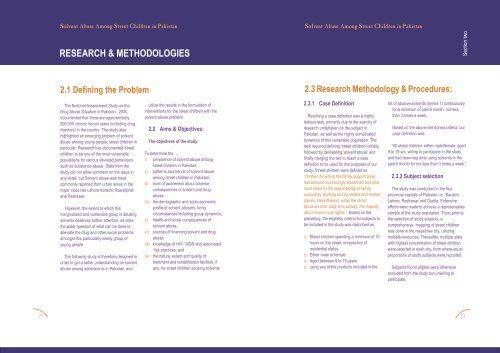solvent-abuse-pakistan
solvent-abuse-pakistan
solvent-abuse-pakistan
Create successful ePaper yourself
Turn your PDF publications into a flip-book with our unique Google optimized e-Paper software.
RESEARCH & METHODOLOGIES<br />
Section two<br />
2.1 Defining the Problem<br />
2.3 Research Methodology & Procedures:<br />
The National Assessment Study on the<br />
Drug Abuse Situation in Pakistan, 2000,<br />
documented that there are approximately<br />
500,000 chronic heroin users (including drug<br />
injectors) in the country. The study also<br />
highlighted an emerging problem of <strong>solvent</strong><br />
<strong>abuse</strong> among young people; street children in<br />
particular. Research has documented Street<br />
children to be one of the most vulnerable<br />
populations for various deviated behaviours<br />
such as substance <strong>abuse</strong>. Data from the<br />
study did not allow comment on the issue in<br />
any detail, but Solvent <strong>abuse</strong> was most<br />
commonly reported from urban areas in the<br />
major cities like Lahore Karachi, Rawalpindi<br />
and Peshawar.<br />
However, the extent to which this<br />
marginalized and vulnerable group is abusing<br />
<strong>solvent</strong>s deserves further attention, as does<br />
the wider question of what can be done to<br />
alleviate the drug and other social problems<br />
amongst this particularly needy group of<br />
young people.<br />
The following study is therefore designed in<br />
order to get a better understanding on <strong>solvent</strong><br />
<strong>abuse</strong> among adolescents in Pakistan, and<br />
utilize the results in the formulation of<br />
interventions for the street children with the<br />
<strong>solvent</strong> <strong>abuse</strong> problem.<br />
2.2 Aims & Objectives:<br />
The objectives of the study:<br />
To determine the …<br />
i) prevalence of <strong>solvent</strong> <strong>abuse</strong> among<br />
street children in Pakistan;<br />
ii) patterns and trends of <strong>solvent</strong> <strong>abuse</strong><br />
among street children in Pakistan;<br />
iii) level of awareness about adverse<br />
consequences of <strong>solvent</strong> and drug<br />
<strong>abuse</strong>;<br />
iv) the demographic and socio-economic<br />
profile of <strong>solvent</strong> <strong>abuse</strong>rs, living<br />
circumstances including group dynamics;<br />
v) health and social consequences of<br />
<strong>solvent</strong> <strong>abuse</strong>;<br />
vi) sources of financing <strong>solvent</strong> and drug<br />
<strong>abuse</strong>;<br />
vii) knowledge of HIV / AIDS and associated<br />
risk practices; and<br />
ix) the nature, extent and quality of<br />
treatment and rehabilitation facilities, if<br />
any, for street children abusing <strong>solvent</strong>s.<br />
2.3.1 Case Definition<br />
Reaching a case definition was a highly<br />
tedious task, primarily due to the scarcity of<br />
research undertaken on the subject in<br />
Pakistan, as well as the highly complicated<br />
dynamics of this vulnerable population. The<br />
task required defining 'street children' initially,<br />
followed by delineating '<strong>solvent</strong> <strong>abuse</strong>' and<br />
finally merging the two to reach a case<br />
definition to be used for the purposes of our<br />
study. Street children were defined as:<br />
“children for whom the family support base<br />
has become increasingly weakened and who<br />
must share in the responsibility of family<br />
survival by working on city streets and market<br />
places. Nevertheless, while the street<br />
becomes their daily time activity, the majority<br />
return home most nights.”. Based on the<br />
preceding, the eligibility criteria for subjects to<br />
be included in the study was described as:<br />
<br />
<br />
<br />
<br />
Street children spending a minimum of 10<br />
hours on the street, irrespective of<br />
residential status<br />
Either male or female<br />
Aged between 9 to 19 years<br />
using any of the products included in the<br />
list of abusive <strong>solvent</strong>s (annex 1) continuously<br />
for a minimum of past 6 month, not less<br />
than 3 times a week.<br />
Based on the above mentioned criteria, our<br />
case definition was:<br />
“All street children, either male/female, aged<br />
9 to 19 yrs, willing to participate in the study<br />
and had been regularly using <strong>solvent</strong>s in the<br />
past 6 month for not less than 3 times a week.”<br />
2.3.2 Subject selection<br />
The study was conducted in the four<br />
provincial capitals of Pakistan i.e., Karachi,<br />
Lahore, Peshawar and Quetta. Extensive<br />
efforts were made to achieve a representative<br />
sample of the study population. Thus, prior to<br />
the selection of study subjects, a<br />
comprehensive mapping of street children<br />
was done in the respective city, utilizing<br />
multiple resources. Thereafter, multiple sites<br />
with highest concentration of street children<br />
were selected in each city, from where equal<br />
proportions of study subjects were recruited.<br />
Subjects found eligible were otherwise<br />
excluded from the study but unwilling to<br />
participate.<br />
8<br />
9


